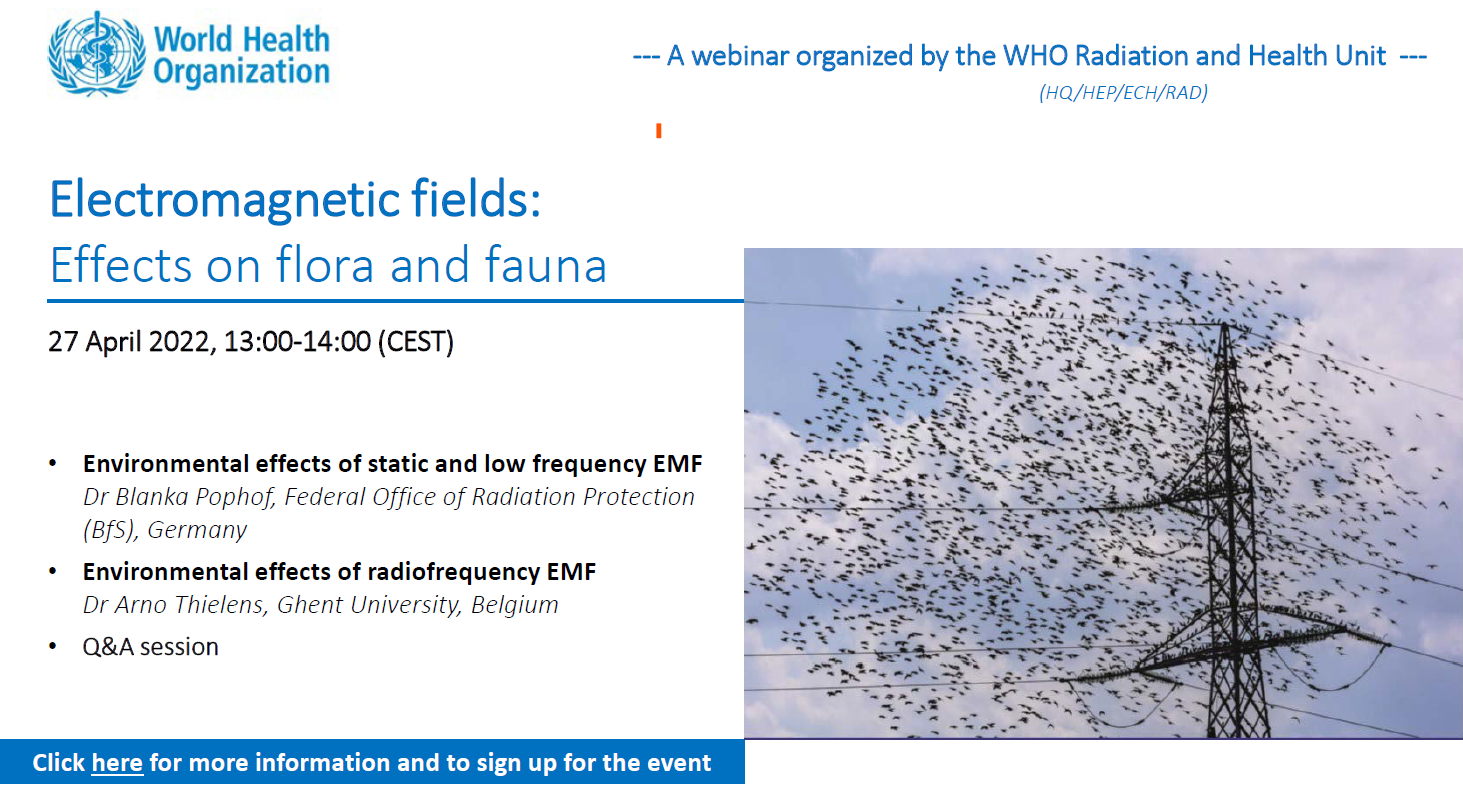13:00-14:00 CEST
Background
Levels of electromagnetic fields (EMF) from human-made sources have steadily increased over the past decades, prompting research on the potential adverse effects from EMF exposure on human health. However, comparably little has been published about the impact of EMF on the living environment, although it is well known that some animal and plant species can perceive electric or magnetic fields.
Most EMF exposures come from increased use of electricity and new technologies. Power grids, which mostly emit static and low frequency fields, are being restructured and expanded due to increasing electricity demand and the switch from fossil fuels to renewable energy sources to address global warming. An ever increasing number of high frequency EMF-emitting technologies are introduced into almost all areas of everyday life. New RF communication infrastructures will have new applications, including in e-health, smart cities, transport and industry.
The webinar will cover possible action mechanisms of these EMF in living systems, and biological effects from these fields as observed in plants, invertebrates and vertebrates. The current state of scientific knowledge will be summarized based on the outcome of an international workshop held in November 2019 and hosted by the German Federal Office of Radiation Protection, and a recent literature review funded by the European Parliament.
Provisional agenda
Moderator: Gunde Ziegelberger (German Federal Office of Radiation Protection, WHO Collaborating Centre)
13:00 – 13:05 - Welcome address – Dr E. van Deventer, WHO
13:05 – 13:25 - Environmental effects of static and low frequency EMF - Dr Blanka Pophof, Federal Office of Radiation Protection (BfS), Germany
13:25 – 13:45 – Environmental effects of radiofrequency EMF - Dr Arno Thielens, Ghent University, Belgium
13:45 – 14:00 - Q&A session
Speakers
Dr Blanka Pophof
Dr Blanka Pophof studied zoology, entomology and animal ecology at the University of Bratislava (Diploma 1987). She performed a doctoral thesis on insect olfaction at Max Planck Institute of Behavioural Physiology in 1993. Her later research focused on electrophysiology and signal transduction in insect olfactory receptor cells and insect orientation. Since 2003 she is involved in research on electric, magnetic and electromagnetic fields at the German Federal Office for Radiation Protection. She coordinated projects on health effects of radiofrequency electromagnetic fields within the German Mobile Phone Research Program, and projects on MRI safety. She is currently involved in research concerning the safety of AC and DC powerlines and 5G, and environmental effects of these techniques.
Dr Arno Thielen
Dr Arno Thielens received the M.Sc. and Ph.D. degrees in engineering physics from Ghent University, Ghent, Belgium, in 2010 and 2015, respectively. He was a PhD student in Ghent University’s information technology (INTEC) department from 2010-2015, where his research focused on electromagnetism and personal exposure assessment to radio-frequency electromagnetic fields. He was a post-doctoral fellow in the same group from 2015 to 2017. From 2017-2019, he was a postdoctoral fellow at the Berkeley Wireless Research Center at the University of California, Berkeley, where he worked on the development of the human intranet. In 2018, Prof. Thielens was appointed as part-time professor at Ghent University. Since 2020, he is also a senior-postdoctoral fellow of the FWO. His main research interests include exposure of living organisms to electromagnetic fields and wireless propagation in and around the human body.

